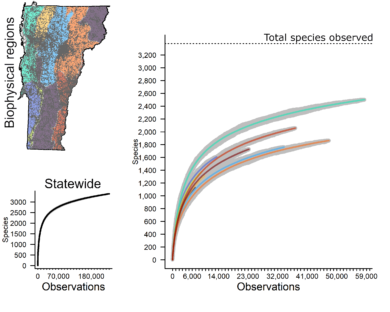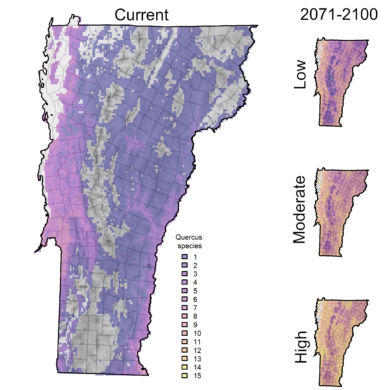Michael T. Hallworth
Nearly 14,000 different species have been observed in Vermont, and with new ones being reported almost daily this time of year, there are likely many more out there. Have you ever wondered how many species live in Vermont, and how the state’s biodiversity will change in the future? The answers to these questions allow us to better understand the world around us, and can also help guide conservation decisions so that future generations can enjoy Vermont’s biodiversity as we have.
Collecting the data needed to address these questions requires expertise….and many years of effort. Imagine the knowledge and time needed to identify every single living thing in your backyard, favorite park, or even just the species you encounter in a single day. Now, imagine doing that for the entire state–that’s a very big backyard! Clearly, it’s more than any one person, or small team of people, could possibly do alone. It requires a large community, and Vermonters have risen to the challenge. The Vermont Atlas of Life, a community science project founded by VCE, began in 2013 with the goal to answer these questions. Since the project’s inception, more than 6.7 million observations from over 390,000 locations across Vermont have been submitted by nearly 20,000 people.

All of these observations allow us to begin answering some of those fundamental questions we asked earlier. Here, I’ll focus on only a portion of Vermont’s biodiversity – plants. Why? They’re easier to monitor because they don’t move around, and they’re incredibly important to all of life in Vermont. Community scientist observations, combined with museum specimens and other data, show that 3,378 plant species have been observed in Vermont (Figure 1). This number is still fluid, and plant species never before seen in Vermont are being discovered, or rediscovered all the time.
Plants play a fundamental role in our ecosystems, and they provide food, habitat, and shelter for many other species. Perhaps unsurprisingly, plant distributions and phenology (when they grow and drop their leaves) are shifting because of climate change. Oaks (Quercus) are a prime example of trees that exist in Vermont, but aren’t really a major part of the Northern Forest tree community that is found in most of the state. Oaks produce acorns that sustain many small mammals through long winters, and also support a disproportionate number of butterfly and moth species. Using the data submitted to Vermont Atas of Life, we predicted where Oak species occur within Vermont today. Then, we modeled where they may occur in the future, based on three carbon emission scenarios (low, moderate, and high; Figure 2). The conditions in Vermont will allow several additional Oak species to occur here as the climate changes. Depending on the amount of carbon released into the atmosphere, our models predict the number of Oak species in Vermont could possibly double within the century.

If you enjoyed this, you will love Vermont Center for Ecostudies upcoming State Of Biodiversity report due out later this year. The State Of Biodiversity report is focused on addressing several outstanding questions such as how many species occur in the state, and where are they in addition to providing the current state of biodiversity in Vermont.

What are the additional oak species that may exist here in the future?